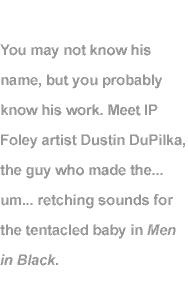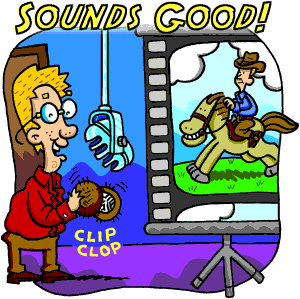 |
|
||||||||||||

|

|
|
By W. Eric Martin
|
Hollywood is built on illusions. And sometimes the illusions are so good that we're willing to accept almost anything we see on the movie screen: Anne Heche, a charming young lesbian, as the love interest of 187-year-old Harrison Ford; Keanu Reeves as the cyberrific second coming of Jesus; Adam Sandler as some kind of a carbon-based lifeform. What goes on behind the scenes can be even more unbelievable. As a prime example, let's take that moment in Notting Hill when Hugh Grant finally gets to smooch Julia Roberts with his skinny little Brit lips: what you're hearing is not the sound of Hugh getting it on with Julia. What you're hearing is the sound of a Foley artist slobbering on his forearm.
Give the Guy Some Credit "Foley artist" is one of those titles that blur past in the closing credits, but it's a pretty important job in movieland. During production, the microphones pick up the actors' dialogue and nothing else. Foley artists, working in sound studios in Los Angeles and New York, have to recreate almost every other sound that a moviegoer expects to hear -- such as the closing of a car door or the snapping of a femur. Dustin DuPilka, a 28-year-old independent Foley artist in upstate New York, has worked on Men in Black, The Boxer, Cop Land, Kundun, The Devil's Own, Addicted to Love, Desperate Measures, and Deconstructing Harry, among other films. He jumps around from studio to studio, but for the most part he has freelanced at C5, Inc. in Manhattan's Chelsea district. "I got into C5 because a friend from film school had started working there and he got me an internship in the summer of 1996," says DuPilka. He adds that while the film school classes themselves were irrelevant when it came to picking up Foley jobs, they did serve a purpose. "At film school, you meet people already in the business and make friends with people a couple of years ahead of you who are already starting to get work. You have to establish a personal rapport with someone at a studio and always call that one person. By using contacts from that first person, you can then branch out to other studios, but you always have to announce who your anchor point is."
Even without connections, it's possible to land a Foley job -- but you can't be above using gimmicks to get a foot in the door. "If you're going in cold, you have to make sure that people remember you," says DuPilka. "If you've seeded your name to the right people, when a job comes up you'll be the one called. One person who came into C5 looking for Foley work actually brought a plate of brownies along with his resume. He got called back because people remembered the dude with the brownies." Those brownies can be more important than a hot resume and a film degree put together. Sound studios know that film school doesn't really prepare you for a life in sound, so if they have the time, they'll give you a shot at playing Foley artist for a day -- even if you have no training whatsoever. "There's no real prerequisite for being a Foley artist other than having unearthly hand-eye coordination and timing," says DuPilka. If you do well, the studio might offer you an internship, which is the only way to break into the Hollywood scene; if you blow it, they'll let you know because there are a thousand other wannabes behind you willing to work for free. Surrounded by Sound... Equipment The 20' x 25' sound stage at C5 looks like an explosion at a garage sale. The walls are lined with baskets, typewriters, old radios, hard plastic containers, sheets of tin, a full set of china, silverware, motorcycle helmets ("Grabbing a helmet makes a very distinctive sound"), car doors, car hoods, free standing doors on doorjambs, a collection of construction-site headwear and a full complement of prop weapons. Bins of denim, nylon, vinyl, and leather clothing, plus drawers and drawers of knick-knacks complete the detonated tagsale look. At C5, DuPilka works with another Foley artist -- usually with someone young like himself, occasionally with his mentor, Marco -- and takes cues from a Foley recordist who's located in a booth that overlooks the sound stage. Making sure he has all his tools on site before starting the project saves him a lot of time down the road. "If all the film reels are on site, we'll watch the movie all the way through before we start, so we can see what kind of props we'll need," he says. "If we need to go searching for props, we can look for everything at once and not chew up more time." Getting a handle on the project that's going to occupy the next three months of his life also gives him a chance to psych himself up. "If there's a lot of running in a certain reel, you have to get ready to sweat all day," says DuPilka. And sweat he will. You have to suffer to make art -- even Foley art. Setting the Stage Like a house designed by some schizophrenic architect, the sound stage has sections of hardwood, dirt, and stone, as well as pits of gravel built into the floor. While he watches the movie play on a three-foot-wide projection screen, DuPilka -- clad in sweats to prevent extraneous noise -- walks, strolls, runs, jogs, and lambadas in place, doing each scene two or three times and changing his shoes to match those of the characters on the screen. He looks divine in powder-blue pumps. After the fancy footwork comes the reenactment of rustling clothes. But just putting on a leather jacket and shambling around like Sylvester Stallone won't cut it. You might swing your arms at the wrong time or not have a sufficiently exuberant leathery crackle -- and with every failed attempt you're wasting money. Lots of money. "If there's any Foley effect that you can't duplicate in three takes, you're not being time-efficient," says DuPilka. "You have to figure out a better way to do it."
This means handling your equipment in ways never intended by the manufacturer. DuPilka explains that the worst way to make a chair squeak is to actually sit on it. "There are too many variables there," he says. For a really nice creak, you have to place one knee on the seat, hold onto the seatback with both hands and lean it back at a 45-degree angle. This will give you complete control over the intensity and duration of the creak. Remember that scene in Deconstructing Harry where Julia Louis-Dreyfus gets shtupped on a creaky table while her lover's blind granny chats in the background? That's right -- Dustin DuPilka, leaning on a chair. "That Bug Doesn't Sound Real Enough" While DuPilka's making noise, the Foley recordist is taping his work and keeping an ear out for trouble. "You'll have disputes over which effect sounds better," he says. "But the recordist sometimes has a better perspective because he's hearing it through the equipment. You have to respect his ability because without a good recordist, you end up with bad Foleys." The director and his sound supervisor are also free with their opinions -- and even though it's really the sound studio that hires DuPilka and not the movie company, he pays attention to their suggestions. When he was interning on The Ice Storm, for example, director Ang Lee was disappointed by the sound of a character sloshing back and forth on a waterbed. "He said that he didn't care how we do it, but he wanted it to be more 'womblike,'" says DuPilka. "I took that to mean sort of wet and claustrophobic. You get into many areas of visualization when making specific sounds." DuPilka also has to get creative because not everything he needs is going to be in his cluttered toychest of a workroom. For a boxing documentary, instead of going out to buy boxing gloves and a punching bag, he made all the punching sounds by beating on a car seat with a two-by-four wrapped in a towel. And that pales next to the work that went into imitating the dragonfly in the opening scene of Men in Black. "Columbia TriStar hired a bug wrangler in L.A. to supply an actual dragonfly -- but the director, Barry Sonnenfeld, said it didn't sound 'real enough,'" says DuPilka. "We ended up using a little toy fan that I found in Toys "R" Us. We wrapped the handle in cloth to muffle the motor, then snipped off the fins and replaced them with duct tape that we had molded in our hands to make more cloth-like. We put three full days of work into it and it came out pretty nice." How long was the scene? "Two minutes." Men in Black also gave DuPilka his first voice role. "I made the retching sounds for the tentacled baby," he boasts.
The competition for choice projects like Men in Black and The Devil's Own is fierce, so he makes sure that whining isn't part of his sound repertoire. "If you emanate an unpleasant vibe, you can forget about getting work," says DuPilka. "There are so many other people who would like your job that we don't need Mr. Friggin' Greyclouds. I mean, I have worked with some skanks and people that smell, but for some reason their personalities kind of transcended all that." Charting Out a Sound Future To take the pain out of the irregularity of Foley assignments, DuPilka has started training as a sound editor to increase his employment opportunities. "It's always a good move to know as much as possible," he says. Getting hired as a sound editor will also allow him to join the Screen Workers Guild, something DuPilka's excited about since Foley artists don't have a union of their own -- but actually landing that job will take more timing than skill. "It's a real Catch-22," he says. "You can't get a job unless you're in the union, and you can't be in the union unless you're working on a film." The only way to wriggle into a sound-editor position is to be offered an assignment with enough lead time so that he can join the Guild before work begins. Having come this far, though, DuPilka has a pretty good idea of how the business works. "I've already done a little sound editing as an intern," he says. "They get free work out of you and you gain the skills that you need to succeed. It's all about mutual exploitation." |
|||||||||||||||||||||||
|
June 19, 2000 Primary Editor: Ken Gordon Illustrator: James Stringer Production: Fletcher Moore |
We'd love to hear your comments about this article! W. Eric Martin is a freelance writer who lives in Blackstone, Mass. If you like, we'd be happy to put you in touch with him, or with anyone named in this article. |
|||||||||||||||||||||||
|
|
||||||||||||||||||||||||